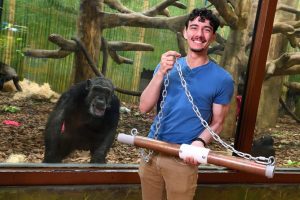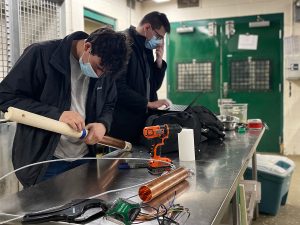
Chimpanzees suffer from the same kinds of heart ailments as humans, and routine EKGs are an important tool used by primatologists to keep the animals’ hearts healthy under human care. However, administering these tests can be a challenge due to chimps’ natural inquisitiveness and fascination with prodding, poking, grabbing, and even chewing anything loose or sticking out. But what if there was a less intrusive solution that could be used on the chimps—or, rather, by the chimps themselves?
Experts at the Maryland Zoo asked, and Whiting School undergraduates delivered, creating PulseApe: a primate-friendly trapeze bar fitted with EKG sensors to capture the chimps’ heart activity while they play and swing. This EKG-in-disguise is now part of the Zoo’s primate-health repertoire.
“Hanging was a behavior that the chimps already had, and the students did a great job of noticing that,” said Pam Carter, area manager for the Chimpanzee Forest at the Maryland Zoo. “The first run-through overall went well, and we got a reading from one of the chimps. I think we’re the only place getting EKGs this way.”
The project started when Carter and her primatologist colleagues at the Zoo came to Alissa Burkholder Murphy, senior lecturer in the Center for Leadership Education and director of its Multidisciplinary Engineering Design program back in 2020.
“The Zoo was open-ended about wanting to monitor some facet of the chimpanzees’ heart health,” said Burkholder Murphy. “I thought the original team would figure out a way to simply monitor the chimps’ heart rate, but through research, they found that detecting arrhythmias was more important, even though it was a harder challenge. So they made getting a full EKG their goal.”

A chimp hangs from the PulseApe device inside an enclosure at the Maryland Zoo.
The original team—Pedro Rivera ’21, Diego Gomez ’22, Max Muss ’22, and Daniel Wang ’22—knew that the Zoo’s primatologists had the chimps hang from a bar to weigh them and decided to work from that concept by fashioning a similar bar outfitted with the circuitry needed to record an EKG. One mechanical problem remained, though: The electronics housed at the center of the bar were not well-protected. In fact, the 3D-printed electronics housing had been chewed through (but not eaten) by a chimp when the first team rolled it out.
Burkholder Murphy revived the project for last year’s Multidisciplinary Design class, thinking that the right mix of student engineering expertise would ultimately get the Zoo a device it could reliably use. Greg Wulffen, a combined BS in mechanical engineering and MS in engineering management student, and Mirza Korman BS ’23, a computer engineering student, turned out to be that winning combination.
“The first thing we did when tackling this project was to think of all the ways a chimp might try to destroy it, and focus in on that,” Wulffen said. “We took what the previous team did and went to the next level to make significant design improvements.”
Wulffen brainstormed ways to make the tube stronger, so the chimps couldn’t get to any of the sensitive components. Using Computer-Aided Design (CAD) software, he finally arrived at using PVC for the inner bar and fashioned the sheath out of Delrin—a thermoplastic that has a higher-fracture toughness— and used a PVC core for the inner bar. A copper pipe covering conducts the electrical signals from the chimp’s hands to the electronics. The team then used Bluetooth to make the entire device wireless, and, with the mentoring of Lucas Buccafusca, lecturer in electrical and computer engineering, refined the interface so the zookeeper could easily decode and extract the EKG data.
After the Zoo confirmed that all materials were safe, it was time to test the device on the intended subject: an energetic chimpanzee. The primatologists, students, and instructor were elated to see their combined years of work pay off in the form of an EKG reading as the chimp happily swung from the bar.

Greg Wulffen and Mirza Komen work on the PulseApe at the Maryland Zoo.
“They hit it out of the park,” Burkholder Murphy said of the teams.
Wulffen is now using his expertise for a Multidisciplinary Design project at the National Aquarium, where he is part of a team designing a durable, corrosion-resistant device to allow visitors to interact with a new underwater Wetlands Exhibit.
“It was quite informative and exciting to see the chimps actually interact with the prototype and learn from how they used it, and how the zookeepers interacted as well,” Wulffen said.